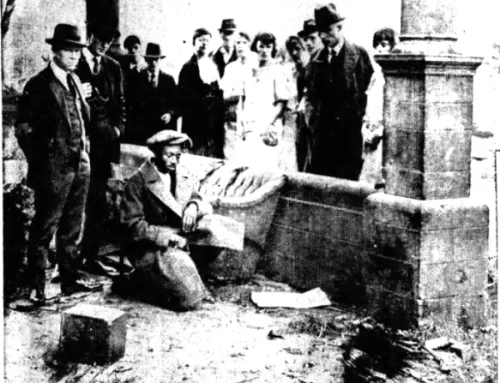The obscure nineteenth-century legislation shaping Wisconsin’s post-Roe reality
By Christina Lieffring
Not many have dug through the physical archive of Wisconsin’s abortion laws, and for good reason. In 1858, the state Legislature’s amendments for the year were recorded by cutting and pasting the printed text of the statutes onto paper that were then notated, bound together by subject with ribbon, and rolled into a scroll secured with more ribbon or string.
As we carefully peeled open one soft-ball-sized scroll that held all the amendments to statutes on criminal law, an archivist joked that it didn’t look like anyone had unrolled it since 1858. (And no, they have not been digitized.)
Then, there it was: Chapter 164, Section 11: Every person who shall administer to any woman pregnant with a quick child, any medicine, drug, or substance whatever, or shall use or employ any instrument or other means, with intent thereby to destroy such child, unless the same shall have been necessary to preserve the life of such mother or shall have been advised by two physicians to be necessary for such purpose, shall, in case the death of such child or of such mother be thereby produced, be deemed guilty of manslaughter in the second degree.
And in red pen that has now faded to pink, a line was drawn under the word “quick.”
Attached to the scroll of amendments is a slip of paper eight inches long and three or four inches wide. On one side it reads: “Strike out the word ‘quick’ as it occurs in sections 10 and 11 of Chap 161 of compiled statutes,” and on the other side, a notation of the chain of events toward passage. Although it looks like a note on a piece of scrap paper, a report on Wisconsin’s abortion laws from the Legislative Reference Bureau (LRB) questioned whether that slip of paper was the amendment itself; it’s not entirely clear.
Either way, “quickening” refers to the point, typically midway through a pregnancy, when a woman can feel the fetus move. The ‘quickening doctrine’ set this as the threshold for when a woman could (and could not) legally obtain an abortion, dating at least as far back as thirteenth century England, and, according to historian James Mohr, it was common law in the American Colonies.
More: What Roe v. Wade’s Dismantling Means for Environmental Justice
When Wisconsin first became a state, in 1848, its abortion law was not drafted through legislation so much as compiled along with other standard criminal statutes. The LRB report found that in 1848 and 1849, three “revisors” were tasked with “filling out” the gaps in the new state’s laws, borrowing heavily–and noticeably–from its fellow newly-formed neighbor Michigan.
One key difference is that the revisors did not incorporate a third statute from Michigan law that banned abortion outright, sticking with the British common law prohibition after quickening. But the 1858 amendment transformed Wisconsin’s abortion law by striking that one word, “quick.” Suddenly, the state went from permitting abortion up to the midway point of a pregnancy to a full ban. That same year, the legislature passed a bill that would also punish women who sought an abortion, though to a lesser extent. While a doctor or midwife could be charged with manslaughter, the woman faced at most six months in jail or a $500 fine.
Both bills were attributed to the influence of William Henry Brisbane, a physician, minister, chief clerk of the state Senate, and founder of Arena, Wisconsin. Brisbane is primarily known in Wisconsin for his strong anti-slavery views, but he was also part of a mid-nineteenth century antiabortion movement spearheaded by physicians.
Mohr wrote that Wisconsin was the third state to enact such laws, not only leading an anti-abortion movement driven by anxieties over the role of women, changing demographics, and medicine in a rapidly changing county, but also raising questions over who should—or shouldn’t—have children, and who should make those decisions.
For physicians, the 1800s were an era of professionalization—standardizing training, licensing, and care procedures, measures that were desperately needed. Even among physicians with formal training, “competence varied widely,” Mohr wrote, because many medical schools were private businesses, reluctant to turn away paying customers (students). “Many medical schools were out and out degree mills, where tuition dollars virtually bought a medical diploma,” Mohr wrote.
Doctors who had attended some of the nation’s better medical schools—which Mohr nicknamed the “regulars”—formed medical organizations that promoted and shared standards based on empirical research. They also attempted to crack down on “quack” practices, though “in truth many of the irregulars advocated courses of treatment less detrimental to health than regulars’ own,” Mohr wrote. Tired of competing with informally trained and unlicensed doctors, the regulars pushed changes to state laws to shore up their authority.
The American Medical Association was formed in 1847, followed by efforts to organize state medical associations so they could flex political power. In Wisconsin, this effort was led by none other than Brisbane. Through the Wisconsin Medical Society and his position as clerk of the state Senate, Brisbane answered the call for physicians to exert political influence.
“From ancient times through the end of the eighteenth century, physicians believed, doctors had occupied positions of high status and great influence,” Mohr wrote. “[One] reason why organizing regular physicians sustained an anti-abortion crusade involved their desire to recapture what they considered to be their ancient and rightful place among society’s policymakers and savants.”
One source of their opposition to abortion was physiological. Instead of seeing quickening as a clear dividing line, many recognized it as one stage in the growth of a fetus. There were also somewhat legitimate concerns that abortion techniques, particularly by informally trained doctors in that era, were less safe than birth itself.
But there was also a pervasive discomfort with allowing women to control their own reproductive health, and who they believed was doing so. In Contraception and Abortion in 19th Century America, Janet Farrell Brodie wrote that “the AMA’s antiabortion campaign and the social purity reformers’ antiobscenity, anticontraception campaign were hostile to women and to the power that control of reproduction promised (or threatened) to give to them.”
In the 1830s and 1840s common birth control methods—such as the rhythm method, douching, the withdrawal method, and abortifacient herbs—once spread through private conversations, were being disseminated through public lectures and publications. This made the information more accessible, but since it was now out in the open, it was a ripe target for blowback.
“A recurrent theme in the 1830s and 1840s was the need to control sexuality,” Brodie wrote. “Fears of unleashed sexuality permeate much nineteenth century literature, much abolitionist polemical literature, as well as advice publications on marriage and family, dress, health, hygiene, and diet. Whether or not they were inhibited or uninhibited in private sexual behavior, many Americans found sexuality profoundly disturbing, and in seeking its control, they sought symbolically, too, larger powers to harness social change in a time of vast social and economic transformation.”
Ultimately, ‘regular’ physicians were the most important force in transforming abortion policy. Horatio Robinson Storer, a Boston-based physician, took the movement nationwide, writing about abortion in national medical journals and urging physicians at the AMA’s 1857 national meeting to take a strong stance against abortion. In 1859, after the AMA conference in Louisville, the AMA officially committed to opposing abortion and organizing to outlaw the practice across the nation.
Conveniently for opponents like Brisbane, those institutions to standardize, license, and organize physicians excluded women, who had, up until that era, made up the vast majority of midwives. The regulars opposed abortion at higher rates than the general populations and did not trust midwives to deny abortion services to their patients.
In the 1840s and ’50s, birth rates declined, and the AMA published multiple papers from physicians across the country attributing that low birth rate to abortion. In one such paper, Storer and Franklin Fiske Heard, estimated that twenty percent of pregnancies in New York were terminated.
More: The Rise of Pennsylvania’s Everyday Left
Brisbane was also concerned with who was obtaining abortions. Because the procedure could be prohibitively expensive, he and many other physicians feared that upper and middle class women were accessing them. “It is an undoubted fact that, especially in high life, and in the middle ranks of society, many wives (and often with the connivance of their husbands) take measures of this kind,” Brisbane wrote to Storer in 1857. “It is my present intention to endeavor to get a law passed by our Legislature to meet the case, much too common, of administering drugs and injections either to prevent conception or destroy the embryo.”
How would such a law be enforced? Oddly, it seems that was beside the point for Brisbane. “It is not probable that any law could be enforced in such cases; but the fact of the existence of a law making it criminal, would probably have a moral influence to prevent it to some extent,” Brisbane wrote to Storer in 1857. “And perhaps in some cases it might be enforced against those who furnish knowingly and designedly the means of procuring the destruction of the embryo or foetus [sic].”
Wisconsin abortion law was amended again in 1878, 1947, 1953, and 1955, all of which built on the 1858 amendments. After Roe v. Wade was decided, bills responding to the Roe decision were passed, including a 1987 bill that removed the penalty for the people who underwent the procedure, and a series of bills by former Governor Scott Walker and the Republican legislature that restricted access for many Wisconsinites.
Now that the Supreme Court has overturned Roe v. Wade, the question that needs to be resolved is which bill ought to be considered state law–the post-Roe bills, which ban abortion after twenty weeks, or the 1858 ban that outright bans all abortion. Until the question is settled, abortion care has been shuttered across the state.
What’s striking, going through the Wisconsin archive, is that Brisbane and the legislature treated this amendment as a side note. Aside from Brisbane’s letters to Storer, there’s little in the historical record on his efforts to change the bill. Brisbane’s diary entries from the time period when the amendment was moving through the approval process are daily logs of the weather, errands, what he purchased and what he planted, with no reflection.
On the day the state Senate decided to take up the amendment, Brisbane wrote that he boarded a train in Duluth at 9:30 a.m., reached Prairie du Chien at 3:30 p.m., bought a coffee for five cents, a train ticket to Arena for $2.35, and arrived at home at 9 p.m. The next day, he wrote, he planted radish, carrot, spinach and sweet corn in his garden. He logs visits to Madison over the subsequent weeks the amendment was debated, but there is no mention of abortion or the amendment.
More than one hundred and sixty years later, a one-word amendment tacked on with a slip of paper is relevant again. Motivated by a desire to control women’s sexuality and to sideline them from the medical field, this law is once again denying people control over their own bodies and putting their lives at risk. ■
Christina Lieffring is a reporter based in Madison, Wisconsin covering state and local politics and history.
Cover image by Chris Harvey.
Belt Magazine is a 501(c)(3) nonprofit organization. To support more independent writing and journalism made by and for the Rust Belt and greater Midwest, make a donation to Belt Magazine, or become a member starting at just $5 a month.






